Organic Gardening as an Artist’s Gateway to the Natural World
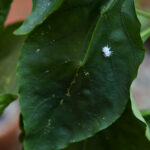
Since its conception, I imagined Diorama Room as being an art space and garden where nature-based art and education can take place. Therefore, during the first Diorama Room hosted project, the Tune in to Green short film series, when we have virtual artist chats we spend some time talking about sustainable art practice, ways we can individually make a difference in the environment, engineering that is underway to assist with the climate crisis, etc. Due to the recent announcement that monarch butterflies are now an endangered species, our latest artist talk ended in brief discussion about organic gardening.
My background in gardening
I can speak on the topic because I gained experience as a gardener from a young age. My great-grandmother and great-grandfather ran a vegetable farm in Wisconsin and although the farm was gone by the time I was born, that side of the family showed me how to raise a wide variety of flowers, fruits, and veggies. My 7th grade science fair project was on the reproduction system of flowers. When I was in my late teen’s I procured close-up filters for my camera and quickly realized that insects were easily accessible subjects that made floral photography more interesting and challenging. Naturally, I wanted to learn about my subjects, so I always researched the plants and insects I encountered with my camera.
Because I lived in apartments, I became a container gardener and gained enough knowledge to get hired as a Garden Doctor, AKA organic gardening consultant, at Garden.com. People would call, send emails, or IM’s asking for plant and insect identification, care tips, and organic pest management tips. We would also recommend plants from our catalog of nurseries, based on their environment.
Over the years I finally had the opportunity to plant in raised beds, directly in the ground, and continued to container garden, gaining deeper hands-on knowledge along the way. Through all of my prior activities with gardening I garnered enough skills to take on the role as Head Gardener at a gorgeous Balinese-style, short-term rental property while earning my MFA.
The teachings from gardens – microcosms of the natural world
In 2021, a short experimental video I made about fireflies was included in a festival at the Ely Center for Contemporary Art in New Haven, CT. I was also selected to speak in a virtual round table talk, called Place, Pandemics, and The Suspension of Time with few other artists in the show, who also work with the environment in their practice. One of them was in Australia and let us know about the Sydney Festival/UTS Big Thinking Forum lecture called, The Art of Nature, on Youtube:
https://www.youtube.com/watch?v=V40EYeC8XcU
The hostess, Larissa Behrendt asks, “Can artists shape the way we think about the environment? What role can creative practitioners play in the transformation of our attitudes and behaviour?”
Amongst the three guests, the comments by Jason de Santolo, a Garrwa and Barunggam tribal member and expert on indigenous methodology and ethics, resonated the most for me. He talked about education that teaches people to be in touch with nature is key to the future of the planet. He affirmed that even intimate conversations on the environment can shift consciousness.
He discussed the writing by Tony Birch that speaks to knowing your own backyard, otherwise you don’t really even understand what you are protecting. Then he shared that he took time away from social media to learn from his partner about gardening and to plant organic seeds with their child to teach them the wonder of the living green world. Finally, he concurred with Birch by saying the garden is an excellent place to start getting a better understanding of the natural world.
Organic gardening 101
So, I’ve decided to put together some of basic organic gardening tips. First off, really get to know what each plant needs regarding amount of sun, type of soil, their companion plants, amount of water, and feeding needs. Some basic organic ingredients that plants love are compost, fish emulsion, and a slow-release organic fertilizer with low N-P-K (nitrogen, phosphorus, and potassium) content. There are blends for a wide range of plants and ones that are more specific to particular plants, like hydrangeas. Many organic sources of nutrients smell unpleasant but you can wear a mask when you apply it to the soil. Chemical fertilizers with high N-P-K amounts flood plants may make them look nice in the short term, which is why many big box nursery suppliers use them but they wash out of the soil quickly. This suddenly leaves the plant without nutrients.
Organic plant foods are also better for the environment than commonly used, high-nitrogen, chemical mixes. High levels of nitrogen used in agriculture, and lawn and golf course maintenance, are one of the culprits responsible for algae blooms in waterways. Algal blooms prevent fish and other aquatic life from being able to come up for air. When these creatures die from lack of oxygen, water birds are also affected. Some types of algal blooms contain toxins which are harmful to humans and animals and have killed dogs, not to mention the water creatures who live and feed there.
The healthier your plants are, the better they are able to withstand disease and insect attacks, which brings me back to entomology. If you want to garden organically, you must get to know the insects in it. Otherwise, you may decide to kill an insect that is not going to harm your plants but is there to eat the insects decimating your garden. Therefore, always know what types of creatures can be affected by the chemicals you choose to spray. Many pesticides harm those beneficial insects, pollinators, birds, and mammals. An alternative is to create a barrier of plants you don’t mind getting eaten around the ones you hope will not.
Beneficial insects
A quick web search on beneficial insects will often turn up ladybugs and praying mantids but there are many others. The less we use chemicals, the more these types of insects will move in and help you control aphids, caterpillars (hopefully not monarchs), and mosquitoes much more effectively than spraying will. For example, at the end of a long heat spell, my milkweed was covered with aphids, and they were starting to gather on my pepper plants too. I tried crushing them and spraying the tops and bottoms of leaves with a combination of dish soap, neem oil, and water but they just kept coming in droves a day or two later. I noticed that a dozen ladybug larvae were snacking on them, so stopped spraying and within a few days the aphids were gone!
Here I would like to highlight some of the lesser-known facts about beneficial insects found in Central Texas and other places in the United States.
Ladybug larvae vs. Mealybugs – Here is a prime example of the internet dangerously steering people wrong. Let’s say you see some white fuzzy insects on your plants and aren’t sure what they are, so you search Google for some insight. Try it. You will find that the entire first page of results are for mealybugs, an insect that sucks the life out of plants. Sadly, due to this incomplete information, many of these wonderful garden helpers may have met their demise. The white fuzzy insects in your garden might actually be ladybug larvae! How to tell the difference: Gently poke the fuzzy white bug with a stick. If it toodles away quickly, it’s probably a ladybug larva. Are there lots of aphids on the plant? It’s probably ladybug larvae eating them. Ladybug larvae also look shaggier than mealybugs.
There are many types of lady beetles. They aren’t all red with black spots. Not all types of ladybugs have larvae that are white and fuzzy like in the photo below. Some look kind of like mini alligators. Their colors vary depending on which type of lady beetle they are. Some ladybugs look like flea beetles, which are both small and black but ladybugs are round, whereas flea beetles are elongated and spring away like fleas when touched. Flea beetles also tend to feed on plants in the brassica family – broccoli, mustard, radish, bok choy, and cabbage. They also like plants in the nightshade family – tomato, eggplant, and peppers. They also tend to make lots of small round holes in leaves. Again, if you see the beetle in question on leaves where there are lots of aphids and ladybug larvae but you aren’t sure which type of beetle it is, it’s probably best to leave them alone!
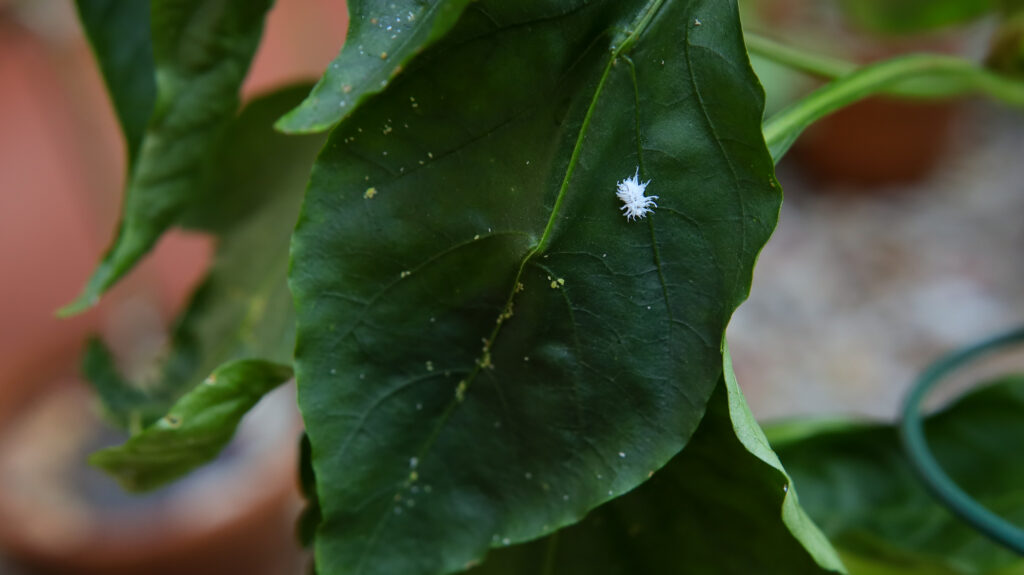
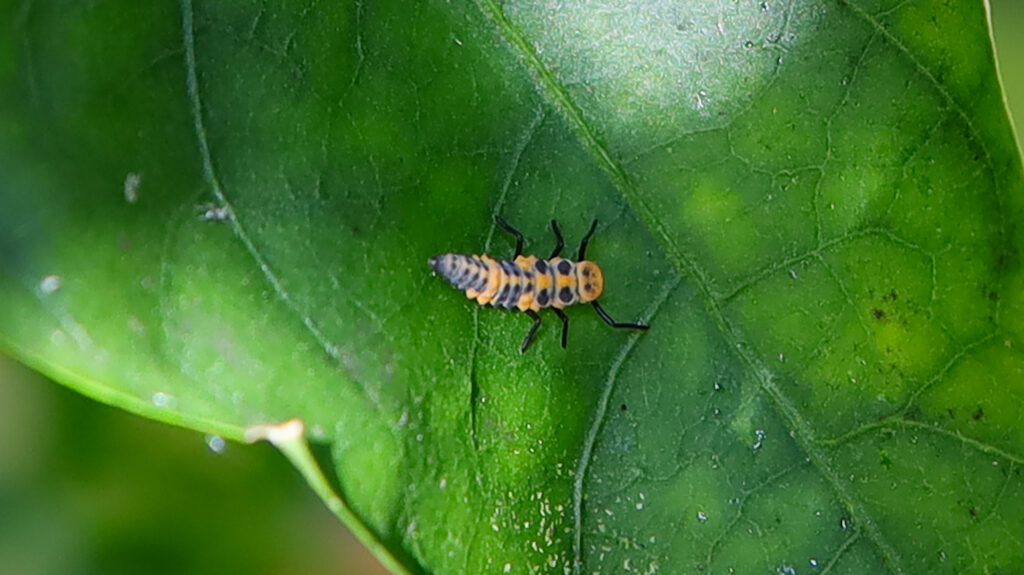
another type of ladybug larva…See how it looks kind of like a mini alligator?
Aphid mummies
If you see something that looks and feels like a hollow, puffed-up shell stuck to a leaf on a plant where a lot of aphids are present, you might wonder if it is an insect egg. These are actually called “aphid mummies”! A tiny wasp, called an aphid parasitoid, has inserted her eggs inside of the aphid. The larva hatches and develops inside of the aphid, which gradually stretches out and dries up into a soft shell which the larvae eventually pupates inside of, like when a butterfly caterpillar creates a chrysalis around itself. When the wasp is full grown, it will use its mandibles to cut its way out of the “mummy”. The picture below may not actually be an aphid mummy but I put it here because they pretty much look like this but most photos I have seen show little legs sticking out, which this one does not appear to have. So this one is probably a Clitostethus arcuatus lady beetle pupae.

Assassin bug vs. leaf-footed bugs
Leaf-footed bugs (see photo below) will eat your fruit and veggies but assassin bugs only eat other bugs. Both of these insects have “beaks” that they stab into their prey before eating them. However, the assassin bugs beaks are much shorter. The leaf-footed bugs are at least half the length of their bodies or longer. The main difference in their appearance though is a leaf shape on their legs, close to their feet.
Unless you find leaf-footed bugs devouring a large quantity of your fruits and/or vegetables, they tend to do minimal damage. However, if you choose to catch them, the easiest way is to fill a jar with vinegar and oil, then slowly approach the bug(s) while placing the jar under them. Quickly push them into the jar with the lid. The grown ones can fly but they are slow. Just in case though, gloves are highly recommended to avoid getting jabbed!

**Please note, that while the leaf-footed bug laying her eggs, in this image is dark gray, there is a gray assassin bug called a wheel bug that shouldn’t be confused with it. The wheel bug has what looks like a cogged gear on its back and is your garden’s friend. Also note that it’s hard to see the beak on this female because it is pressed against her body, underneath.
“Junk bug”
You may see a pile of debris moving around in your garden or on your patio. Not to be confused with bag worms, whose disguise looks like an organized bundle of conical-shaped tiny twigs. “Junk bugs” will use dead bugs, flower petals, and shed insect skins to hide itself from predators. So what are they?! They’re green lacewing larvae. You know, those wonderfully pretty flying insects that eat mosquitoes! Like ladybugs, I sometimes wrangle them. If they seem to be wandering aimlessly but I have a plant under attack by aphids or whiteflies, I put a stick in front of them to walk on, then relocate them to my plant. In the bottom right of the “junk bug” in the photo below, you can see two thin brown mandibles grabbing a white aphid or spider mite. In the video you can see it slide the pest into its mouth.
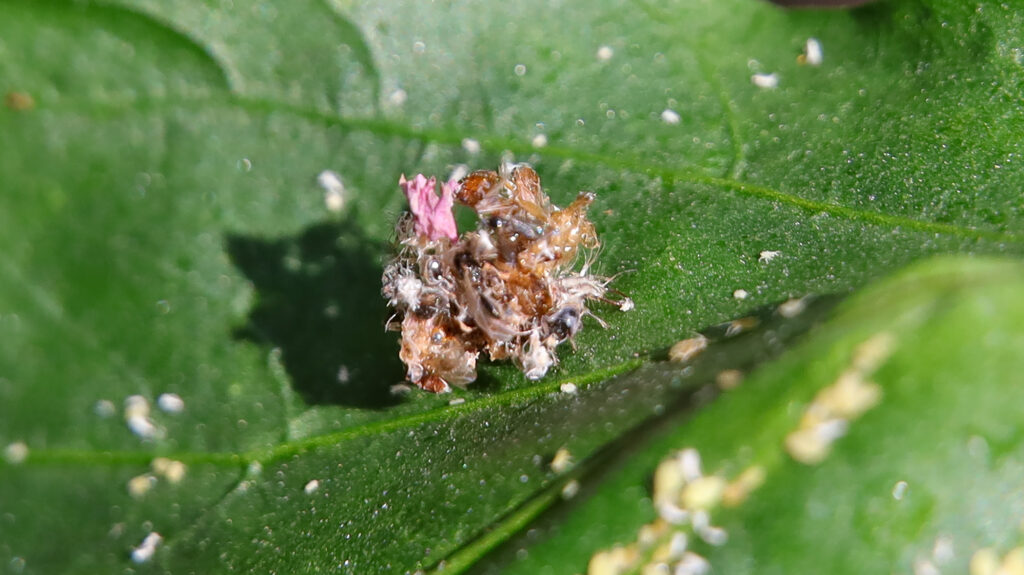
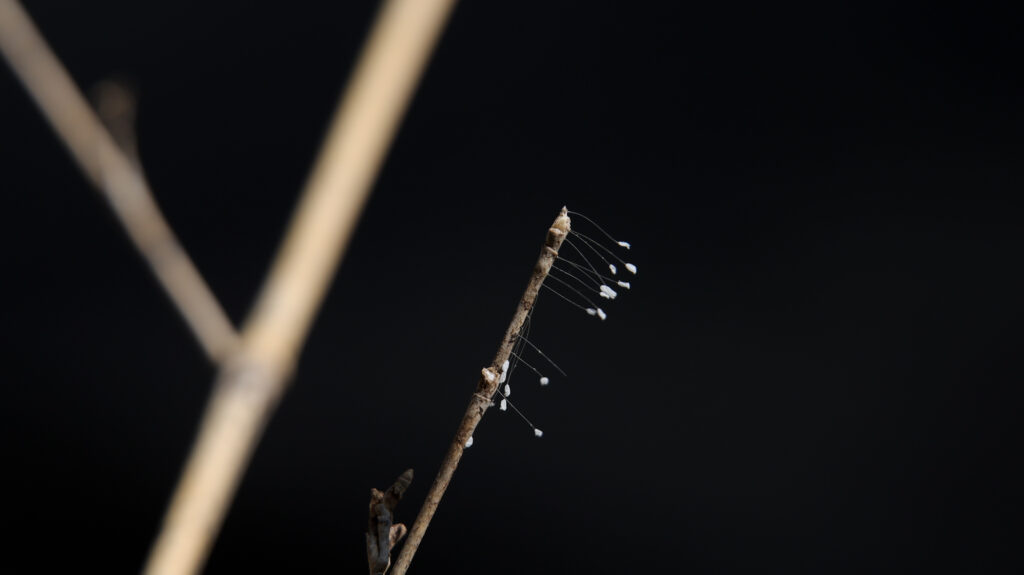
green lacewing eggs
Paper Wasps
These insects get a bad rap! They are pollinators just as bees are. As you can see from this video, they also kill and eat caterpillars and grubs, which can destroy your garden by decimating plant leaves and roots. Hand picking larger pests, like tomato hornworm, is sometimes the best way to get them under control but wasps are a good back up for the ones you miss.
Paper wasps aren’t aggressive unless you bother their nest. Trying to knock it down with broom it down or spraying it will only agitate them. They can sting multiple times, so seriously think twice before being aggressive towards them.
There is a paper wasp nest right by our front door but they have never been bothered us when we were entering or exiting our house. I did rent a room in a house where the wasps outside the sliding patio door would lightly bop us when we entered the deck. The home owner soaked q-tips with sugar water and held it near their nest until one come sit on it and take a little sip! He did this regularly and they stopped bopping us!
Ensign wasp
The females of these midnight blue wasps are cockroach casing hunters. They search for the casings where hundreds of cockroach eggs are contained, then insert their own eggs inside of it. When the ensign wasp larvae hatch, they eat the cockroach eggs. These wasps are sensitive to boric acid, so if you use powdered boric acid as a barrier around your house to kill roaches, switch to tablets that roaches will eat but won’t get onto the wasps seeking them out.
As you can see from this video, ensign wasps have a characteristic way of moving. The tip of their stinger is flat and is attached to a separate tail piece that bobs up and down. This is unusual for a wasp, as most of them have a stinger at the tip of a rounded abdomen.